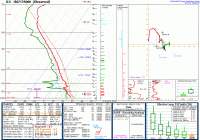Joe Jeffers
Thinking that the SPC is letting this slip under the radar with only having a marginal risk issued. Supercell composites of 90 and with the level of wind shear I think there is a chance of some tornadoes. What's your input?
Thanks for your input with my limited training I am glad to hear from someone that is more knowledgeable on the subject. This was the composite I was looking at. Please if I am misreading let me know I would love to learn!

